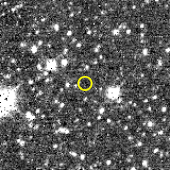 Near-infrared photograph of Lysithea (center) by the 2MASS survey | |
| Discovery [1] | |
|---|---|
| Discovered by | Seth B. Nicholson |
| Discovery site | Mt. Wilson Observatory |
| Discovery date | 6 July 1938 |
| Designations | |
Designation | Jupiter X |
| Pronunciation | /laɪˈsɪθiə/[2][3] |
Named after | Λυσιθέα Lysithea |
| Adjectives | Lysithean /laɪˈsɪθiən/[4] |
| Orbital characteristics [5] | |
| Epoch 27 April 2019 (JD 2458600.5) | |
| Observation arc | 79.87 yr (29,171 days) |
| 0.0782144 AU (11,700,710 km) | |
| Eccentricity | 0.1478734 |
| +258.57 d | |
| 27.18992° | |
| 1° 23m 32.227s / day | |
| Inclination | 26.29254° (to ecliptic) |
| 343.46495° | |
| 94.80010° | |
| Satellite of | Jupiter |
| Group | Himalia group |
| Physical characteristics | |
| 42.2±0.7 km (WISE)[6] 42.2±3 km (occultation)[7]: 6 | |
| 12.78±0.10 h[8] | |
| Albedo | 0.036±0.006[6] |
Spectral type | C/P[6] |
| 18.2[9] | |
| 11.2[5] | |
Lysithea /laɪˈsɪθiə/ is a prograde irregular satellite of Jupiter. It was discovered by Seth Barnes Nicholson in 1938 at Mount Wilson Observatory[1] and is named after the mythological Lysithea, daughter of Oceanus and one of Zeus' lovers.[10]
Lysithea did not receive its present name until 1975; before then, it was simply known as Jupiter X. It was sometimes called "Demeter"[11] from 1955 to 1975.
It belongs to the Himalia group, moons orbiting between 11 and 13 Gm from Jupiter at an inclination of about 28.3°.[12] Its orbital elements are as of January 2000. They are continuously changing due to solar and planetary perturbations. It is gray in color (B−V=0.72, V−R=0.36, V−I=0.74) and intermediate between C-type and P-type asteroids.[13][6]

- ^ a b Cite error: The named reference
Nicholson1938was invoked but never defined (see the help page). - ^ "Lysithea". Dictionary.com Unabridged (Online). n.d.
- ^ Cf. also 'Lysithous' in Noah Webster (1884) A Practical Dictionary of the English Language
- ^ Yenne (1987) The Atlas of the Solar System.
- ^ a b Cite error: The named reference
MPC115890was invoked but never defined (see the help page). - ^ a b c d Cite error: The named reference
Grav2015was invoked but never defined (see the help page). - ^ Cite error: The named reference
JOA2021-2was invoked but never defined (see the help page). - ^ Cite error: The named reference
Luu1991was invoked but never defined (see the help page). - ^ Cite error: The named reference
SheppardMoonswas invoked but never defined (see the help page). - ^ Marsden, Brian G. (7 October 1975). "Satellites of Jupiter". International Astronomical Union.
- ^ Payne-Gaposchkin, Cecilia; Katherine Haramundanis (1970). Introduction to Astronomy. Englewood Cliffs, N.J.: Prentice-Hall. ISBN 0-13-478107-4.
- ^ Jacobson, R.A. (2000). "The orbits of outer Jovian satellites" (PDF). Astronomical Journal. 120 (5): 2679–2686. Bibcode:2000AJ....120.2679J. doi:10.1086/316817. S2CID 120372170.
- ^ Grav, Tommy; Holman, M. J.; Gladman, B. J.; Aksnes, K. (2003). "Photometric survey of the irregular satellites". Icarus. 166 (1): 33–45. arXiv:astro-ph/0301016. Bibcode:2003Icar..166...33G. doi:10.1016/j.icarus.2003.07.005. S2CID 7793999.